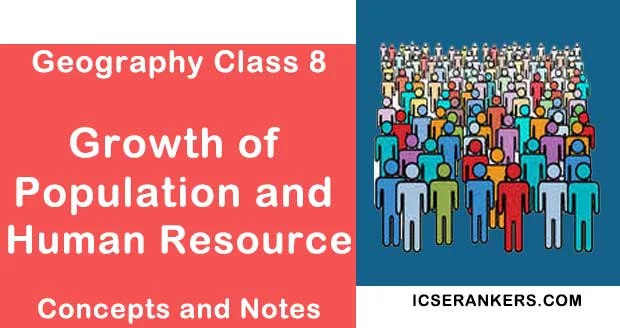Growth of Population and Human Resource- Geography Guide for Class 8

Information about Growth of Population and Human Resource
Title | Growth of Population and Human Resource |
Class | Class 8 |
Subject | Class 8 Geography |
Topics Covered |
|
Growth of Population
Population is always in a state of flux. The net change in population between two fixed periods of time expressed in percentage is called the growth rate of population. The growth rate may be negative, if the population declines; and positive, if it increases during a given time period.
The growth of population is affected by:
- birth rate
- death rate
- by the large scale migration.
It increases when birth rate is more than the death rate or when the in-migration is more than the out-migration.
The world Population was around 1.5 billion in the year, 1900, which has grown to the present population of 7.0 billion in the year, 2011. This suggests that the growth rate has been rising up and population has been continuously increasing rapidly.
The growth in population of India has rapidly increased during the last century. In particular, it has gone up from about 400 million in 1961 to over a billion people in the year, 2011. In these 50years, the country has added more than 700 million people which makes the growth rate alarming. It is estimated that at this rate of growth in population, the country will almost double its population in next 36 years.

Composition of Human Resources
The composition of Human Resources include different attributes of the population.
It includes:
- age structure
- sex-ratio
- literacy rate
- ratio of rural-urban population
- working
- non-working Population, etc.
All these parameters play an important role in reflecting occupation, lifestyle and social status of the population.
Let us study three important attributes of human resource, i.e. age structure, sex-ratio and literacy rate.
Age Structure
Age structure of population is an important component of demographic structure. It refers to the number of people belonging to different age groups.
Generally, the population is categorised into three broad age groups, i.e.
- People below 14 years comprising of young population.
- People between 15 years to 59 years make up adult population.
- People between 59 years and above as old population.
A large number of children below 15 years and older people above 59 years come under dependent population. On the other hand, the number of people in the age group of 15-59 years is defined as the productive population as they are biologically most reproductive and economically active. This group also acts as an indicator of population productivity.
Sex-Ratio
It is a ratio between the number of females and males in a population.
- The sex-ratio is expressed as number of females per thousand males.
It has been observed that in European countries, number of females is more than males. Thus, Europe has high or favourable sex-ratio. Rising sex-ratio has been recorded since the early 1980s and has since then continued to increase with no signs, of reversing. In India, the sex-ratio was recorded as 943 in 2011 which has declined from 972 as recorded in 1901.

Sex-ratio in India is declining due to several reasons. Of these, most common are:
- Preference for male child due to social, economic and religious reasons.
- Infant mortality is higher among girls than among boys because of lack of proper medical facilities.
- General neglect of female children during childhood is largely responsible for high female mortality rate.
- Pre-natal sex determination tests, inspite of ban, continue to large scale practice of female foeticide.
Among the Indian states, the state of Kerala had highest sex-ratio of 1084 and Haryana had the lowest sex-ratio of 879 in the year 2011.

Literacy Rate
Literacy rate is the percentage of people who can read and write in a certain country. Literacy rate varies from country to country and from rural to urban population in the same country. It is more among male than female population, more in urban areas than in rural areas. The literacy rate of any country is an important indicator as it affects the socio-economic development of a nation.
The people of a country are its real wealth. They make use of country's resources. Population is an asset for the country rather than a liability. It is an important indicator of the socio-economic strength of a country. Population becomes human capital when there is investment made in education, health and skill development. Thus, investment in human capital yields highest return. Therefore, in the entire process of development, the focus should be on the well-being of human beings.
